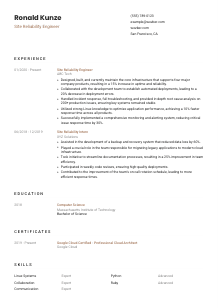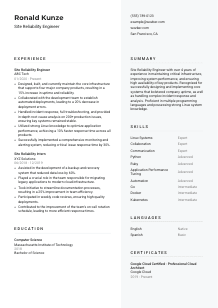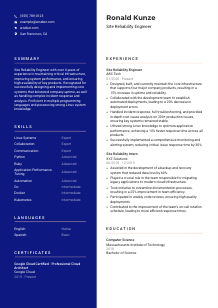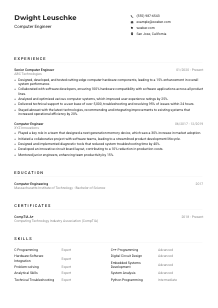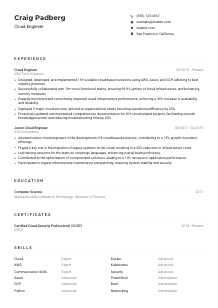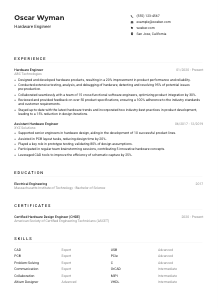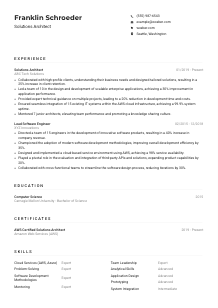Site Reliability Engineer CV Example
Keeping systems stable, but your CV feels shaky? Dive into this Site Reliability Engineer CV example, crafted using Wozber free CV builder. Learn how to merge your reliability tricks with job specifications, ensuring your career graph stays as smooth as the services you monitor!
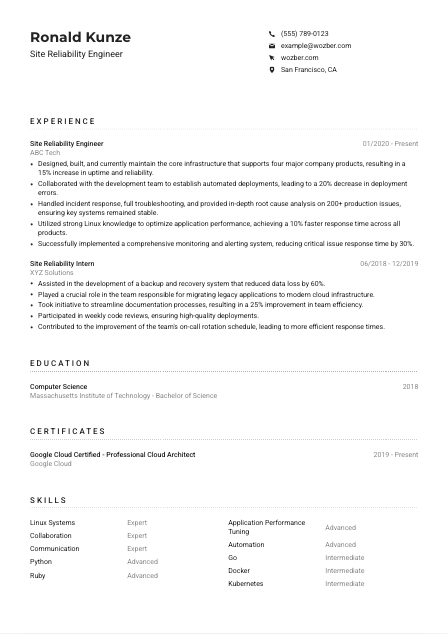
How to write a Site Reliability Engineer CV?
Hey there, future site reliability maestro! As the digital backbone of today's tech-driven world, your role in ensuring system stability is more critical than ever. However, before you can start troubleshooting systems or otimizing infrastructure, you need to tackle the first challenge: crafting a CV that speaks directly to hiring managers and passes the stern gaze of Applicant Tracking Systems (ATS). Using the Wozber free CV builder, let's journey through creating an ATS-compliant CV that positions you as the ideal candidate for that Site Reliability Engineer role you've got your eye on.
Ready to gear up? Buckle in, and let's engineer a CV that not only ticks all the right boxes but does so with finesse and precision.
Personal Details
Let's kick things off at square one - your personal details. It's more than filling out a few fields; it's about setting the stage for your professional story. Here's how to optimise this section specifically for a Site Reliability Engineer role, making it immediately clear to hiring managers that you're positioned perfectly for the role.
1. Bold Identity
Your name is your marquee. Ensure it's prominently displayed in a clear, bold font that's a tad larger than the rest of the text. This is your first opportunity to make an impression, so don't let it slip past.
2. Sync with the SRE Title
Immediately below your name, align yourself with the role by stating your profession or the job title you're targeting - "Site Reliability Engineer." This simple step aligns your identity with the job at hand, letting the hiring manager know they're looking at a focused candidate.
3. Contact Essentials
Include your phone number and a professional email. These details are your digital handshake - make sure they're correct and professional. A pro-tip: your email format should ideally be firstname.lastname@email.com, ensuring a polished touch.
4. Geographical Match
Since the job description specifies San Francisco, CA, ensure your location aligns with this. If you're local, great; it's one less hurdle for consideration. If you're willing to relocate, make sure to explicitly mention this in your cover letter or summary.
5. Web Presence
In today's digital age, having a LinkedIn profile or personal website that showcases your portfolio or projects can give you an edge. Make sure it's updated and reflective of your CV to maintain consistency.
Takeaway
The personal details section is your CV's opening handshake. Make it confident, clear, and aligned with the Site Reliability Engineer role you aspire to. Think of it as laying down the first brick in the foundation of your professional narrative.





Experience
The experience section is the powerhouse of your CV, demonstrating your journey through the trenches of system reliability, performance optimisation, and cross-functional collaboration. Here's how to craft an experience section for your Site Reliability Engineer CV that resonates with the essence of the role and speaks volumes about your capabilities.
- Designed, built, and currently maintain the core infrastructure that supports four major company products, resulting in a 15% increase in uptime and reliability.
- Collaborated with the development team to establish automated deployments, leading to a 20% decrease in deployment errors.
- Handled incident response, full troubleshooting, and provided in‑depth root cause analysis on 200+ production issues, ensuring key systems remained stable.
- Utilized strong Linux knowledge to optimise application performance, achieving a 10% faster response time across all products.
- Successfully implemented a comprehensive monitoring and alerting system, reducing critical issue response time by 30%.
- Assisted in the development of a backup and recovery system that reduced data loss by 60%.
- Played a crucial role in the team responsible for migrating legacy applications to modern cloud infrastructure.
- Took initiative to streamline documentation processes, resulting in a 25% improvement in team efficiency.
- Participated in weekly code reviews, ensuring high‑quality deployments.
- Contributed to the improvement of the team's on‑call rotation schedule, leading to more efficient response times.
1. Decipher the Job Descriptor
Start by thoroughly digesting the job description. Highlight keywords that resonate with your own experience such as "designed, built, and maintained core infrastructure" or "implemented automated deployments." These are gold mines for tailoring your CV.
2. Chronology and Clarity
Present your experience in reverse chronological order, starting with the most recent. This section is not just a timeline; it's the story of your growth and impact. Be clear and concise, ensuring each role and accomplishment is relevant and significant.
3. Targeted Achievement Bullet Points
Now, it's showtime. For each role, tailor your achievements to echo the job description. For example, "Designed, built, and currently maintain the core infrastructure...resulting in a 15% increase in uptime and reliability." Quantify your results wherever possible to add substance.
4. Metrics that Matter
Numbers speak louder than words. Wherever possible, quantify your impact. If you reduced deployment errors by 20%, say it. This quantification provides a tangible measure of your contributions and achievements.
5. Relevance Reigns
While it might be tempting to list all your past roles, focus on those that align closely with the requirements of a Site Reliability Engineer. Irrelevant experiences can dilute the impact of your CV, so aim for precision over volume.
Takeaway
Your experience section is a testament to your journey and achievements in the world of site reliability. By highlighting relevant experiences and quantifying your impact, you're not just telling hiring managers what you've done; you're showing them what you're capable of achieving in their role.
Education
In the realm of Site Reliability Engineering, your education is the bedrock of your technical knowledge. Crafting this section with attention to detail can further emphasize your readiness for the role. Let's navigate through otimizing this section to complement the role you're pursuing.
1. Identify Key Education Requirements
First off, ensure your highest level of education aligns with the job's requirements. For the Site Reliability Engineer role, a "Bachelor's degree in Computer Science, Engineering, or a related field" is specified. List yours if it matches, as it's a foundational requirement.
2. Simplify the Structure
Keep this section straightforward and easy to skim. Your degree, the institution's name, and your graduation year are crucial. For instance, 'Bachelor of Science in Computer Science, Massachusetts Institute of Technology, 2018.'
3. Degree Relevance
Here you emphasize the relevance of your degree to the role. For a Site Reliability Engineer, degrees in computer science, engineering, and related fields are highly pertinent. Match your listed degree closely with those highlighted in the job listing.
4. Highlight Pertinent Courses or Projects
Especially for recent graduates or those transitioning to site reliability, listing relevant courses, projects, or thesis work can bolster your profile. Though if you're a seasoned professional, this may be less necessary.
5. Other Academic Achievements
Graduating with honors or specific recognitions that underscore your commitment and success in relevant areas? Mention them here. Remember, the more senior your targeted role, the more you should focus on professional rather than academic achievements.
Takeaway
Your education section confirms your foundational knowledge for the Site Reliability Engineer role. Tailor it to highlight degrees and courses relevant to the field, cementing your status as a highly educated candidate ready to tackle the role's challenges.
Certificates
In the rapidly evolving tech landscape, certifications can serve as powerful endorsements of your skills and expertise. For a Site Reliability Engineer, certain certifications can significantly uplift your CV. Let's delve into how to effectively incorporate this section.
1. Survey Job Requirements
Begin with a thorough examination of the job description. While the provided job description didn't specify certifications, including relevant ones like 'Google Cloud Certified - Professional Cloud Architect' can greatly bolster your appeal.
2. Choose Relevant Certifications
Prioritize certifications that showcase your knowledge and skills pertinent to site reliability engineering. It's about quality, not quantity. Each certification listed should clearly communicate your commitment to maintaining and enhancing your expertise in the field.
3. Date Transparency
For certifications, especially those in technology, validity matters. Indicate the date of acquisition to show currency. For ongoing validity, like '2019 - Present,' it reassures the employer of your up-to-date expertise.
4. Remain Proactively Up-to-date
The tech field is always on the move, with new advancements and practices emerging. Continuously update your certifications and pursue new ones that align with your career goals and the evolving demands of Site Reliability Engineering.
Takeaway
Your selection of certifications is a testament to your ongoing commitment to professional growth. By carefully selecting and updating certifications relevant to Site Reliability Engineering, you're showcasing not just your current expertise, but also your dedication to staying ahead in a fast-paced field.
Skills
Your skills section is a condensed showcase of your professional toolbox. For a Site Reliability Engineer, this means highlighting a blend of technical expertise, problem-solving capabilities, and collaboration skills. Let's highlight the route to otimizing your skills for the role at hand.
1. Decipher Explicit and Implicit Skills
Begin by breaking down the job description. Identify both the stated (e.g., "Proficient in scripting languages such as Python, Ruby, or Go") and the implied skills (e.g., problem-solving skills inferred from "handle incident response").
2. Match and List Your Relevant Skills
Now, align your skills with those mentioned or implied in the description. If you're proficient in "Linux Systems" and have strong "Collaboration" skills, those should be at the top of your list. This direct correlation makes your fit for the role undeniable.
3. Organize and Prioritize
Structure this section starting with the skills most critical to a Site Reliability Engineer. Ensure it's neatly categorized if you have a mix of technical and soft skills. This organized presentation helps hiring managers quickly ascertain your suitability.
Takeaway
A well-crafted skills section strongly asserts your capability and readiness for the role. Tailoring this section to reflect the job's demands demonstrates not only your qualifications but also your strategic fit for the position. Let your skills shine, showcasing you as a well-rounded Site Reliability Engineer.
Languages
In our globally connected world, linguistic capabilities can open doors and break barriers. While the primary requirement for a Site Reliability Engineer might be technical prowess, showcasing language skills can often add an appealing dimension to your profile.
1. Job Description Language Prerequisite
The job description explicitly mentions proficiency in English. This is your cue to place English prominently in your languages section with the proficiency level clearly stated, e.g., 'Native' or 'Fluent.'
2. List Additional Languages
Knowing additional languages can be an advantageous soft skill, demonstrating your ability to communicate with diverse teams or stakeholders. If you know languages beyond what's required, list them succinctly, highlighting the level of proficiency for each.
3. Honesty in Proficiency
Accuracy in portraying your language proficiency is key. Use terms like 'Native,' 'Fluent,' 'Intermediate,' or 'Basic' to describe your skill level. This clarity helps set realistic expectations for your linguistic capabilities in professional settings.
4. Role's Scope and Communication Needs
For roles with a global reach or diverse team collaborations, insightfully showcasing your language skills can substantially enhance your candidacy. Even if not a primary requirement, additional languages speak to your versatility and adaptability.
5. Continuous Learning
If you're on a journey to learn a new language, consider mentioning it if relevant to the role. This learning spirit is often welcomed, showing an openness to growth and engagement with diverse cultures or markets.
Takeaway
Your language capabilities, alongside your technical skills, fortify your profile, showing you're not just technically adept but also poised to thrive in collaborative and diverse environments. Highlighting your linguistic proficiency can thus subtly but effectively elevate your candidacy.
Summary
The summary section of your CV offers a golden opportunity to encapsulate your qualifications, skills, and professional ethos in a few impactful sentences. For a Site Reliability Engineer, this means distilling the essence of your technical and collaboration prowess. Let's craft a summary that sets the stage for your detailed CV.
1. Capture the Role's Essence
First, understand what lies at the heart of the role. A Site Reliability Engineer is not just about maintaining systems; it's about proactive improvement, collaboration, and technical wizardry. Your summary should reflect these core elements.
2. Spark Interest with Your Introduction
Kickstart your summary with a powerful opening that positions you as a passionate and skilled Site Reliability Engineer. Phrase it in a way that captures attention right off the bat, for instance, 'Site Reliability Engineer with over 4 years of experience in maintaining critical infrastructure...'
3. Echo Key Requirements and Achievements
Weave in specific skills and achievements that resonate with the job description, such as 'Recognized for successfully designing and implementing core systems that bolstered company uptime...' This specificity makes your fit for the role crystal clear.
4. Brevity with a Punch
While it's tempting to cram as much as possible into this section, remember, the summary is just a teaser. Keep it concise but powerful, ensuring each word earns its place. Your goal is to entice the hiring manager to dive deeper into your CV.
Takeaway
Your summary is the hook that draws the hiring manager in. Craft it with care, highlighting your alignment with the Site Reliability Engineer role and the unique value you bring. This high-level snapshot is your chance to make a memorable first impression, setting the tone for the detailed narrative that follows.
Launching Your Site Reliability Engineer Journey
You're now equipped to shape a CV that doesn't just pass through the ATS but stands out to hiring managers as well. Your journey as a Site Reliability Engineer is about blending technical finesse with a keen eye for system stability and performance. Each section of your CV is a building block towards presenting yourself as the ideal candidate for the role. Lean on the insights provided, use the ATS-friendly CV template from Wozber, and let your CV be the launchpad for your next career milestone.
The path is set, your tools are ready – it's time to step forward and claim your place among the tech trailblazers. Remember, every great journey begins with a single step, and yours starts with a polished, tailored CV. Go ahead, make your mark.

- Bachelor's degree in Computer Science, Engineering, or a related field.
- Minimum of 3 years of experience in a SRE or related role.
- Proficient in scripting languages such as Python, Ruby, or Go.
- Strong knowledge of Linux systems and application performance tuning.
- Ability to collaborate effectively with cross-functional teams and possess excellent communication skills.
- Must be linguistically adept in English.
- Must be located in San Francisco, CA.
- Design, build, and maintain the core infrastructure to support our products.
- Analyze system performance and implement optimizations.
- Implement automated deployments, monitoring, and alerting systems.
- Collaborate with development teams to ensure products are scalable and reliable.
- Handle incident response, troubleshooting, and root cause analysis for production issues.





